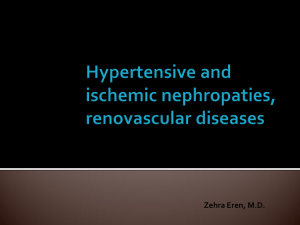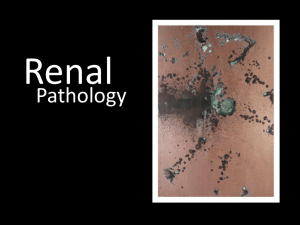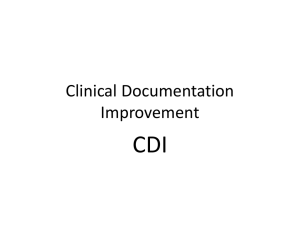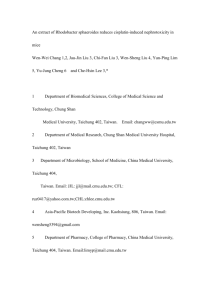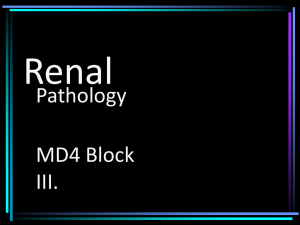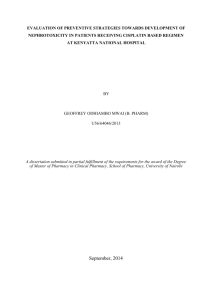Cytostatic drug and radiation associated renal lesions (PPT / 6790 KB)
advertisement
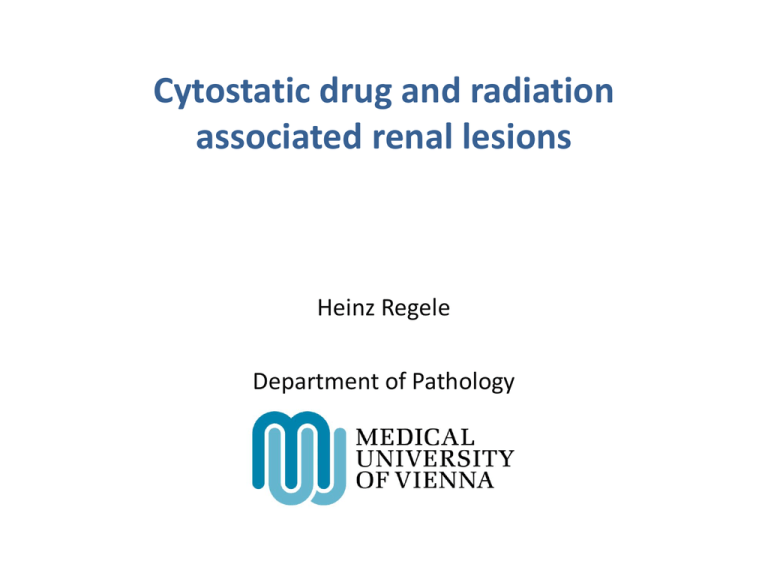
Cytostatic drug and radiation associated renal lesions Heinz Regele Department of Pathology Cytostatic drug and radiation associated renal lesions Radiation Clinical: Acute and/or chronic renal failure Histology: Radiation nephritis/nephropathy Cytostatic drugs Cisplatin (Ifosfamide) Clinical: Acute and/or chronic renal failure Histology: Tubulointerstitial injury Renal injury in cancer treatment Radiation Clinical: Acute and/or chronic renal failure Histology: Radiation nephritis/nephropathy Cytostatic drugs Cisplatin (Ifosfamide) Clinical: Acute and/or chronic renal failure Histology: Tubulointerstitial injury Bisphosphonates Pamidronate, Zoledronate… Clinical: NS, acute or chronic renal failure Histology: Glomerular injury and/or tubular injury Targeted therapies VEGF blockade Tyrosine Kinase Inhibitors (TKI) Clinical: Proteinuria, acute renal failure Histology: Glomerular injury Radiation induced kidney lesions •TMA like changes in glomeruli and arteries: GBM double contours, mucoid intimal swelling •Acute tubular injury •Glomerular scarring •Intimal fibrosis •Interstitial fibrosis and tubular atrophy Radiation nephropathy more appropriate than radiation nephritis Radiation nephropathy Diagnostic challenges Long latency phase after exposure Clinical signs become detectable after months or years • months • Chronic radiation nephropathy: Acute radiation nephropathy: 6-12 2-10 years (with or without acute phase) Diagnostic features are non-specific Clinical: reduced GFR Histology: and chronic tubular injury, Hypertension, proteinuria, edema, urinary casts, TMA like changes in glomeruli and arteries, acute glomerular scarring, intimal fibrosis, interstitial fibrosis might be due to many RT is frequently combined with other nephrotoxic agents/conditions other types of injury Concomitant cytostatic drug therapy Effects of cytostatic drugs, antibiotics or GvHD might aggravate effects of TBI especially after BMT Kidney injury is dose dependent Dawson LA, Int J Rad Oncol Biol Phys 2010 Schematic risk estimation for kidney injury in partial kidney radiation therapy Dawson LA, Int J Rad Oncol Biol Phys 2010 Renal injury by radiolabeled peptides and antibodies Radionuclide labeled small proteins Somatostatin analogs (octreotide): Neuroendocrine tumors (NET) Upcoming new agents • Glucagon-like peptide 1 receptor (exendin-4): NET • Gastrin-releasing peptide receptor (bombesin) : Breast and prostate cancer • αvβ3 Integrin (aeg-gly-asp (RGD)): Proliferating endothelial cells • CCK2 (gastrin) receptor (gastrin-1): Medullary thyroid carcinoma Pool SE, Sem Nucl Med 2010 Hydrophilic radiolabeled peptides are excreted mainly via the kidneys and are partially reabsorbed in proximal tubular cells. Renal retention of therapeutic radionuclides causes a relatively high radiation dose to the kidneys, which can lead to kidney failure. Vegt E, J Nucl Med 2010 Cisplatin induced renal injury Cisplatin and related platinum-based therapeutics are frequently used for the treatment of testicular, head and neck, ovarian, cervical, non-small-cell lung carcinoma and many other types of cancer. Cisplatin nephrotoxicity is a frequent dose limiting side effect which occurs in about one third of patients undergoing cisplatin treatment. Clinical Cisplatin nephrotoxicity is often seen after 10 days of administration with decreasing glomerular filtration rate, increased serum creatinine, and reduced serum magnesium and potassium levels. Pathophysiology Main targets are (predominantly proximal) tubular epithelial cells. Drug induced cell death occurs via apoptosis and necrosis Mechanisms of Cisplatin nephrotoxicity Pabla N, KI 2008, KI 2008 Cisplatin induced renal injury Histology is non-specific and renal biopsies are rarely performed during early stages. Renal (tubular) dysfunction may persist over years especially if cisplatin was combined with ifosfamide. Chronic cisplatin nephropathy is however not clearly defined. Effects of multimodal therapy or co-morbidity may be confounders in late biopsies. Bisphosphonates Bisphosphonates are inhibitors of osteoclast mediated bone resorption. They are frequently used in the treatment of post menopausal osteoporosis and against lytic bone lesions in MM or bone metastases Only high dose i.v. application of bisphsponates used in malignacy associated bone disorders is associated with nephrotoxicity Renal lesions typically occur after several months of treatment indication cumulative injury which was also demonstrated in experimental animals Nephrotoxicity of Bisphosphonates Collapsing FSGS Acute tubular injury Pamidronate Zoledronate Histology and outcome of Bisphosphonate renal injury Perazella MA, Kidney Int 2008 Anti-angiogenic cancer treatment Cook KM, CA Cancer J Clin 2010 Anti-angiogenic cancer treatment Cook KM, CA Cancer J Clin 2010 Receptor Tyrosine Kinase Inhibitors (rTKI) (VEGFR inhibiting) Cook KM, CA Cancer J Clin 2010 Renal side effects of VEGF inhibition Kappers MHW, J Hypertens 2009 High-grade proteinuria (>3.5g/day) upon VEGF inhibition Incidence of high-grade proteinuria with bevacizumab according to dosage and tumor type Wu S, JASN 2010 Renal lesions during VEGF inhibition Izzedine H, Eur J of Cancer 2010 Conditional VEGF gene deletion in podocytes Eremina V, NEJM 2008 VEGF is required for normal GEC function Eremina V, NEJM 2008 Does VEGF inhibition cause podocyte injury? Sugimoto H, J Biol Chem 2003 Does VEGF inhibition directly cause podocyte injury? Studies in whole body and cell specific VEGFR-2 KO mice Normal glomerular function requires paracrine but not autocrine VEGF-VEGFR-2 signaling Sison K, JASN 2010 Summary Renal injury is common in radiation therapy and cytostatic drug treatment especially with platinum based agents and ifosfamide Biopsies are rarely performed in these conditions, histologic lesions are non-specific and an overlap with other pathologies can be diagnostically confounding I.v. application of bisphosphonates is associated with significant (dose dependent) risk of glomerular (pamidronate) or tubular (zoledronate) nephrotoxicity Antiangiogenic therapy targeting VEGF signaling frequently leads to proteinuria and sometimes cause glomerular TMA. Clinical and experimental findings in VEGF inhibition might provide clues to the mechanisms of other types of TMA (preeclampsia…) Proteinuria and TMA may also be caused by receptor tyrosine kinase inhibitors (rTKI)


